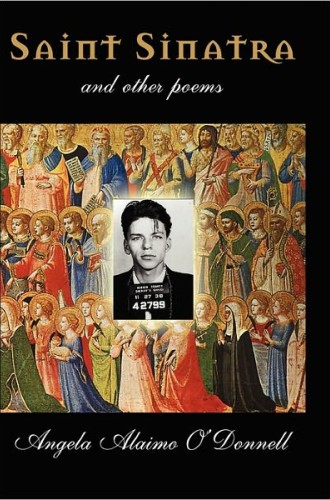Saint Sinatra and Other Poems, by Angela Alaimo O’Donnell
Angela O’Donnell’s deliciously sassy poems are born of her deeply Catholic imagination. A professor of English and the associate director of the Curran Center for American Catholic Studies, O’Donnell builds a house of saints, canonized or not, including some who have never been associated with sainthood in the traditional sense of the word.
To begin with, what qualifies Frank Sinatra as a saint? “St. Sinatra” is a tribute to the irresistible charm of the blue-eyed crooner, who turns girls into devotees by singing “a true tune we know and can’t carry.” He is the “Hoboken Hero of Eros,” and readers may find themselves part of those who plead with him in the final couplet, “Pray for us, Sinner.” The volume’s cover art shows, against a golden backdrop of traditional saints, Sinatra’s mug shot from the time he was arrested on a morals charge in 1938. Despite his shady past, the brilliance of Sinatra’s performance makes him a holy vessel, worthy to intercede on behalf of the believers in his art; it endows him with the power to “Sing us alive.”
Read our latest issue or browse back issues.
In its playful content and swing-jazzy form, “St. Sinatra” is an alluring entrance. O’Donnell sorts her saints into six sections (“Sisters,” “Brothers,” “Speaking in Tongues,” “Seeing Through Not with the Eye,” “Holy Ground” and “Household Saints,” with a poem of “heresy” ending each section). O’Donnell’s selection ranges from canonical saints like St. Catherine of Siena (or, more casually, St. Kate); biblical characters like the practically minded St. Martha, begrudging her sister’s time at Jesus’ feet; legendary artists like St. Vincent (Van Gogh), painting the world in whorls of colors; to literary giants like St. Melville and even his villainous hero, St. Ahab. Part of what makes this collection so daring is the poet’s clear refusal to draw conventional boundaries between good and evil, body and spirit, secular and religious arts, the beatified elect and the unblessed mediocrities. The book even includes Mozart’s nemesis, “St. Salieri.”
Saint Sinatra and Other Poems is also a celebration of the sensual pleasure of poetry. The entire volume is marked by the distinct joy O’Donnell takes in the sound and rhythm of language. In the concluding poem, in which she calls the reader to “crack k’s with your crowns / roll l’s across your taste-budded tongue,” we hear the voice of a female poet whose creations beckon to readers with a hearty “mangia!” And so we do. We lip-synch along with Edna St. Vincent Millay (“What lips my lips have kissed and where and why / are lips my lips have missed, and so I try”) and enjoy the fine rhymes and taut rhythmic structure found in a number of O’Donnell’s poems like well-defined muscles.
The deftly crafted sonnet that opens the “Household Saints” section is an ekphrastic poem inspired by a charcoal drawing by Margie Crisp, “Inferno on Dumbwater Creek,” which also happens to be on the cover of O’Donnell’s debut poetry collection Moving House. The dramatic description of a burning house is followed by the responses (or lack thereof) from things that are present on the scene: the moon, the windows, the clouds. The image of a collapsing house provides a viable counterpoint to the poetic structure of O’Donnell’s book, which enshrines both orthodox and unorthodox saints. The house could symbolize one’s past and present homes, the architectural arrangement of a poetry manuscript, a house of God, even the Catholic Church. The poet’s fiery imagination seems to cleanse and bring new life to stagnant, calcified notions of faith and art.
The debated link between faith and art occupies much of “The Conversation,” a long six-part poem placed in the book’s middle. It is based on the final meeting between Thomas Merton, the iconoclastic Trappist monk and author, and Czeslaw Milosz, the acclaimed Polish poet and political exile. This open-form, quote-driven poem doesn’t showcase O’Donnell’s sonic mastery, and despite the title, the collage of quotes does not synthesize into a conversation but portrays the two great minds talking past each other. Still, a scene of such “minds” joining for a night of a fleshly feast is artfully rendered.
What underlies this scrumptious dinner is the tension between the maker and the made, the singleness of the universal faith and the delightful multiplicity of the world. If the art of verse-making calls the poet to become, indiscriminately, legions of people and things of this world, are we to call it a work of demons or angels?
As we exit O’Donnell’s eclectic house of saints and unique hagiography, she leaves us with what’s more a puzzle than an answer. The final poem, “Poet’s Heresy,” pronounces poetry “lies & truth, death & life,” “every thing & no thing at all.” The end of the poem adopts eucharistic language: “It is my body & blood. / Here. Take. Eat.” Is poetry equal to sacrament? The gravity of such a notion is best understood by those who have tried their hand at writing poetry. No matter whether the verse is about saints or devils, writing it is an act of giving oneself away, though not without artifice, disguise and awareness of one’s limitations. What comes out of the poet is and isn’t real.
O’Donnell’s collection of poems provides a Walt Whitman of menus, mirroring her serious engagement with the corporeal essence of Catholic imagination and its symphonic appetite. Its variety is pleasurable and challenging. It is also an act of faith.






